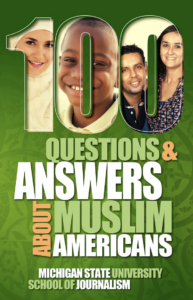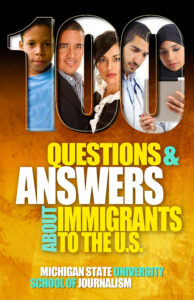Be a Bias Busters ally on Giving Tuesday, Nov. 30. The same kind of effort that helped make this guide wants to send students to Amish Country in 2022. Please join us as a crowd-funding ally by contributing or sharing this crowd-funding campaign with YOUR network. Let’s make a difference together and give more students this eye-opening experience. Thank you!
These are some of the items from “100 Questions and Answers About Arab Americans,” available from Amazon or the Front Edge Publishing bookstore. Available in print or digital editions.
Who are Arab Americans?
What race are Arab Americans?
Who are some well-known Arab Americans?
Who are Chaldeans?
Are Chaldeans Arabs?
When do I say Arab, Arabic or Arabian?
Are Arabs terrorists?
Where do Arab Americans live?
To which places do Arab Americans trace their ancestry?
Is Iran an Arab country?
Is Palestine a country?
Are marriages arranged?
Are there Arab conventions for naming children?
Do Arab Americans have a shared religion?
Are most Arabs worldwide Muslim?
What is the difference between Islam and Muslim?
What does hajj mean?
Why do some Arab women wear garments that cover their head or face?
Some Arab men wear a checked garment on their heads. What is that?
What is that charm with the eye or an eye on a hand?
Who are Arab Americans?
Arab Americans are U.S. citizens or permanent residents who trace their ancestry to, or who immigrated from, Arabic-speaking places in the Middle East. That is in southwestern Asia and northern Africa. We call that region the Middle East. Not all people in this region are Arabs. Most Arab Americans were born in the United States. Learn more. | Back to top
What race are Arab Americans?
There are no distinct Arab physical characteristics. Arabs may have black, brown, blond or red hair and blue, brown or green eyes, and have skin tones that range from very dark to very light. The U.S. Census classifies all people of Arab or Middle Eastern ancestry as white (Caucasian), though many Arab Americans see themselves differently. Learn more. | Back to top
Who are some well-known Arab Americans?
Christa McAuliffe, the teacher/astronaut who died aboard the space shuttle Challenger; Indy 500 winner Bobby Rahal; Mothers Against Drunk Driving founder Candy Lightner; Hollywood actor and producer Tony Shalhoub; Paul Orfalea, the founder of Kinko’s and Jacques Nasser, former president and chief executive officer of Ford Motor Co. Learn more. | Back to top
Who are Chaldeans?
Chaldeans are Catholics from Iraq. A religious and ethnic minority there, Chaldeans have some large communities in the United States, the largest in Detroit. The Chaldean Catholic Church has had connections with the Roman Catholic Church since 1551, and has been affiliated since 1830. The Chaldean Diocese of the Catholic Church in the United States has parishes in Michigan, California, Chicago and Arizona. It also has several missions. Churches offer Chaldean language services. Chaldeans and Assyrians, along with Arabs, are Semite people. The cultural foundation is similar, but the religious affiliation is different. Learn more. | Back to top
Are Chaldeans Arabs?
Chaldeans and Arabs have cultural and political similarities, but different identities. The Chaldean language is different from Arabic. In Iraq where Chaldeans originate, they are religiously distinct from the Muslim majority. While Chaldeans foster a separate identity, they also share an Iraqi nationality and share some concerns with Arabs. These nuances are lost by federal classifications, which sometimes reclassify Chaldeans as Arab or Iraqi. It is best to ask people how they identify themselves. Learn more. | Back to top
When do I say Arab, Arabic or Arabian?
Arab is a noun for a person, and it can be used as an adjective, as in “Arab country.” Arabic is the name of the language and generally is not used as an adjective. Arabian is an adjective that refers to Saudi Arabia, the Arabian Peninsula, or for things, such as an Arabian horse. When ethnicity or nationality is relevant, it is more precise and accurate to specify the country by using Lebanese, Yemeni or whatever is appropriate. Learn more. | Back to top
Are Arabs terrorists?
Terrorists of many ethnicities operate all around the globe. High-profile attacks have brought U.S. attention to terrorists in or from the Middle East, and the U.S. State Department has identified many groups with Arab connections. However, it is inaccurate to assume that, because people are Arabs or Arab Americans, they are involved in terrorism or, when an attack occurs, that Arabs must be involved. Learn more. | Back to top
Where do Arab Americans live?
Arab Americans live in all 50 states. About a third of them are concentrated in California (272,485), Michigan (191,607) and New York (149,729). Another third of them are in these seven states: Illinois, Maryland, Massachusetts, New Jersey, Ohio, Texas and Virginia. The institute estimates that 94% of Arab Americans live in metropolitan areas. The top five are Los Angeles, Detroit, New York/New Jersey, Chicago and Washington, D.C. Learn more. | Back to top
To which places do Arab Americans trace their ancestry?
The umbrella organization, the Arab League, has 22 members. They are Algeria, Bahrain, Comoros Islands, Djibouti, Egypt, Iraq, Jordan, Kuwait, Lebanon, Libya, Mauritania, Morocco, Oman, Palestine, Qatar, Saudi Arabia, Somalia, Sudan, Syria, Tunisia, United Arab Emirates and Yemen. Learn more. | Back to top
These estimates are from the U.S. Census Bureau’s American Community Survey for 2006-2010:
Lebanese: 485,917
Egyptian: 179,853
Syrian: 147,426
Palestinian: 83,241
Moroccan: 74,908
Iraqi: 73,896
Jordanian: 60,056
Yemeni 29,358
Learn more. | Back to top
Is Iran an Arab country?
No. Although Iran borders Iraq, it originated in the Persian Empire and has a different language and cultural history from Arab countries. The dominant language in Iran is Farsi, not Arabic, although other languages are spoken there as well. Persian is sometimes used to describe either the language or the ethnicity, but Farsi and Iranian are not interchangeable. Iran’s location, the fact that it is an Islamic country, and the similarity of its name to Iraq can confuse people. Learn more. | Back to top
Is Palestine a country?
Historically, Palestine was a country east of the Mediterranean Sea that includes current-day Israel and parts of Jordan. As a distinct region, Palestine was under Ottoman control (a Turkish empire) and then British control until 1948, when the nation of Israel was created. Areas of Palestine became Israel and part of Jordan. Today, Palestine is under an autonomous government. The United Nations General Assembly in 2012 upgraded it to a non-voting observer state. Palestinians share a collective national identity and are moving toward independence and self-rule as a country. Areas of Palestine remain under Israeli occupation as negotiations continue between Palestinian authorities and the Israeli government to find a permanent agreement. The Palestinian National Council acts as the government. Learn more. | Back to top
Are marriages arranged?
This is very rare in the United States, except among some of the most recent immigrants. Remember that most Arab Americans were born here, and that they frequently marry people from other cultures. In the case where a marriage is arranged, a parent may recommend someone from another family or from the country of origin, but the child is not forced to marry that person. More typically, couples meet and ask their families’ approval before getting engaged, or make their own decision and then tell their families. As with many cultures, it can be traditional to seek the blessing of parents on both sides for couples seeking to marry. Learn more. | Back to top
Are there Arab conventions for naming children?
Depending on their religion, Arabs often name their children after people in the Bible or the Quran. Both holy books contain many of the same people. For instance, Yusif is Joseph, Mussa is Moses, Ibrahim is Abraham and Issa is Jesus. Muslims often name boys after Muhammad, the prophet who founded Islam. Although names can indicate religion, don’t assume this to be always true. Arab tradition may call for the father’s name to be the middle name of sons and daughters. Learn more. | Back to top
Do Arab Americans have a shared religion?
No. Arab Americans practice many religions including Christianity, Islam, Druze, Judaism and others. Most Arab countries are predominantly Muslim. So are some non-Arab countries, such as Turkey and Indonesia. Although Arabs are connected by culture, they have different faiths. Culture and religion are different. While most Arabs in the world are Muslim, most Arabs in the United States are Christian. Learn more. | Back to top
Are most Arabs worldwide Muslim?
Yes, although most Arab Americans are Christians. In Lebanon, the largest ancestral homeland for Arab Americans, almost 20 religions are practiced. There, the population is about 54 percent Muslim and 41 percent Christian. There are more than 20 million Christians in the Arab world. Learn more. | Back to top
What is the difference between Islam and Muslim?
Islam is the religion, and a Muslim is a person who follows the religion. It is like the difference between Christianity and Christian. The adjective is Islamic. Learn more. | Back to top
What does hajj mean?
Al hajj refers to the pilgrimage to Mecca by millions of Muslims once each year. It is a milestone event in a Muslim’s life. A man who makes the trip is recognized with the title hajj, for example, “Hajj Ahmad.” For women, the title is hajjah, though pronunciation varies. Muslims who are financially and physically able to do so are expected to make the journey at least once in their lifetime. Many like to do it more than once. Learn more. | Back to top
Why do some Arab women wear garments that cover their head or face?
This practice is a religious practice, related to Islam, and not a specifically Arab tradition. While some say that veiling denigrates women, some women who dress this way say it liberates them. Some say it is more oppressive to be expected to dress in revealing ways. This practice of modesty, called hijab, is not universally observed by Muslim women and varies by region and class. Some governments have, at times, banned veiling and at other times required it. In American families, a mother, a daughter or a sister might decide to cover her head while the other does not. Most Arab Americans dress like other Americans. Learn more. | Back to top
Some Arab men wear a checked garment on their heads. What is that?
It is called a kafiyyeh and it is traditional, not religious. Wearing the kafiyyeh is similar to an African American wearing traditional African attire, or an Indian woman wearing a sari. The kafiyyeh shows identity and pride in culture. Different styles and colors of the kafiyyeh can have significance. Learn more. | Back to top
What is that charm with the eye or an eye on a hand?
Often worn as jewelry, the hamsa was a non-religious symbol for good luck or protection that pre-dated Islam. It is seen in many cultures including Latin American, Greek, Ethiopian and Turkish. People from many traditions and religions have adopted it. Some Muslims call it the “hand of Fatima.” She was a daughter of the prophet Muhammad. Learn more. | Back to top



















